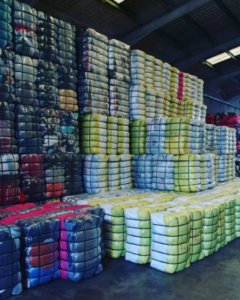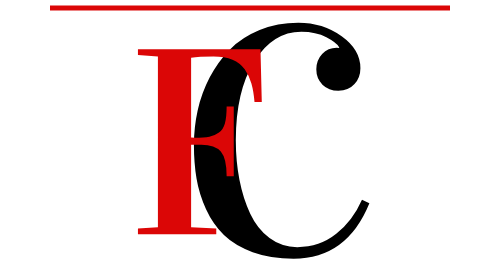Secondhand clothes arrive in Ghana in bales, as you may have guessed from your exploration of our website.
The majority of these bales are 55kg or 120 lbs, however, some can weigh up to 200 lbs. Each bale is organized by item type, such as men’s jeans, ladies’ shirts, men’s suits, and so on.
The number of things per bale ranges from 40 to 600 (depending on weight and/or kind of garment), but our study shows that the average number of items per bale across garment types is 200.
Three elements influence the price per bale: weight or quantity of items, garment type, and country of “origin” (where the clothing was collected).
Second-Hand Clothing Bales Price in Ghana
According to our studies, bales can cost more than 2,000 Ghana Cedi (about $400 USD), with the average cost per bale being 750 Ghana Cedi (approximately $150 USD).
We discovered through surveys and anecdotal evidence that bales from the United States and Canada are the cheapest because they are of the lowest quality.
Bales from the United Kingdom are generally the most expensive. Let us fast forward… When a retailer (someone who buys individual bales from a middleman or an importer in order to resale individual items of clothing) receives her bale, the first thing she does is cut it open (the bales come wrapped in plastic and wire) and sort the contents into 3-4 classes known as selections.’
The first selection is the greatest and includes clothes with price tags still attached (this might be price tags from charity/secondhand shops in the global North such as Goodwill), deadstock from retailers/brands, or lightly used trending or ornamented products.
According to our research, the first selection counts for an average of 18% of each bale.

The second selection includes lightly worn goods in good shape that are the proper size for the retailer’s market. The second selection accounts for 30% of the bale on average.
Anything that appears worn is out of style, is damaged, is not the correct clothing kind, or is the wrong size is the third option. The third selection accounts for more than 45% of each bale on average.
The remainder is classified as ‘asei,’ or rubbish, and is frequently dumped onto the ground to be disposed of in a landfill. Retailers rely on the first selection.
The first selection may be less than 20% of the volume of the bale, but it is 70% of the value required for merchants to recoup the cost of the bale. Retailers risk losing money if bales do not have enough first selection. This is frequently the case.
The value acquired via a second selection may help a merchant break even, but businesses rarely earn a profit without a significant first selection. Sometimes retailers hire “Selectors” who keep up with trends to assist them in determining which things fit in which selection.
Retailers know whether or not they will make their money back within an hour of cutting a bale. This is stressful for retailers, who are essentially gambling with each bale they purchase. The selection procedure is also important in determining how much of the clothing delivered to Ghana is really purchased and given a “second life” as opposed to being discarded.
While the third selection is not automatically discarded, nearly half of the third selection is never sold. Furthermore, some of the first and second choices will go unsold and will be relegated to the third choice.
Some of the second and third selections may be purchased (or given away) in quantity and shipped to a market in a neighboring nation or rural Ghana. Nonetheless, our analysis indicates that half of the third selection will be transported to a landfill or disposal site. Most of the time, this happens within a week of a bale landing at Kantamanto.
We discovered that on average 40% of every bale is either taken directly to landfill or is somehow unaccounted for financially, representing a major lost value for traders and a significant expense for the City of Accra.
The Accra Metropolitan Authority pays for 70 metric tons of garment trash from Kantamanto to be transported six days a week to the Kpone Landfill in Tema (except on holidays). Private trash businesses and individual waste carriers send more garments to the dump and informal, illegal landfills.
Although clear data on the amount of clothing waste handled by the informal sector have been difficult to come by, we believe that informal services treat between 35% and 40% of all clothing waste created in Kantamanto based on anecdotal and photographic evidence.
These figures add up to almost 40% of the “used” apparel shipped to Kantamanto Market to be reused not being reused. This is a significant problem that requires our attention. The material, environmental, and social consequences of this lost value have become the primary focus of our investigation.
Where Can I Buy Bales Of Second-Hand Clothes In Kumasi?
Apy’s Couture sells affordable bales of second-hand clothes in Kumasi.
Use the WhatsApp button to contact us now.
ALSO SEE: How Much Is A Bale Of Used Clothes In Nigeria?
Do Store Reject Clothes In Ghana?
Some stores will reject damaged clothes in Ghana.
Uk Used Clothes Suppliers In Ghana
Apy’s Couture is the #1 UK-used clothes supplier in Nigeria, Ghana, and Africa as a whole.
Use the WhatsApp button to contact us now.

I am interested to do business with you
I need to buy a bale of clothes am in kumasi
No comment for now because is my first time to get in touch with you pls how much is your first grade for boys and girls thanks
How much a bale cost?
Pls I want bale to buy pls my number 0593532XXX
How much is a bale of children tops and jeans for boys and girls.am in Nigeria and the waybill is how much.